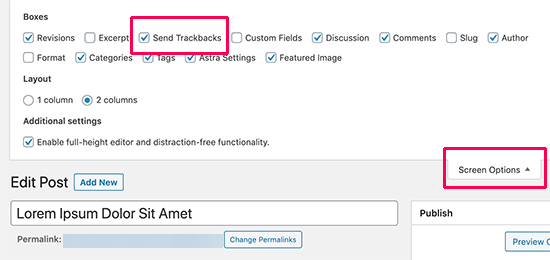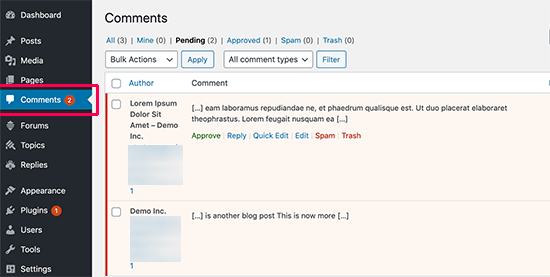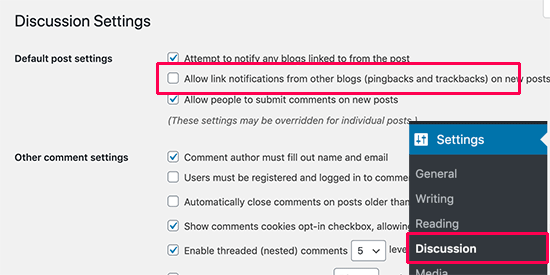Lately a consumer requested us about trackbacks and pingbacks in WordPress. In addition they needed to understand how these two options can be utilized extra successfully.
Trackbacks and pingbacks are modes of communication between WordPress blogs. They’ve been round because the early days of running a blog, however only a few customers find out about these options.
On this article, we’ll clarify trackbacks and pingbacks in WordPress. We’ll discuss their distinction, how they work, and how one can use them.
What’s a Trackback?
Trackbacks give bloggers the power to speak between web sites. Its nearly like one particular person saying to a different “That is one thing chances are you’ll be all for”.
Right here is how trackbacks work in WordPress:
We write a submit on our weblog.
You need to touch upon our submit, however you need your personal readers to see what it’s a must to say and capable of touch upon it.
You’ll then write a submit by yourself weblog and ship a trackback to our weblog submit. (By default, WordPress doesn’t let you ship handbook trackbacks whereas writing a weblog submit).
We’ll obtain your trackback, and select to show it as a remark or not. The remark show will likely be a title, excerpt and a hyperlink to your weblog submit.
What’s a Pingback?
Pingbacks give blogs the power to speak by means of an automatic system. It’s nearly like distant feedback.
Right here is how pingbacks work in WordPress.:
We write a submit on our weblog.
After that you just write a submit in your weblog mentioning/linking to our article.
Your running a blog software program will mechanically ship our weblog platform a pingback.
Our running a blog software program will obtain the pingback. It’ll then mechanically go to your weblog to verify that the pingback originates there, and the hyperlink is current.
After that, we can have the power to show your pingback as a remark. It will solely be a hyperlink to your web site.
Pingbacks additionally work inside your web site. Because of this when you hyperlink to one in every of your personal articles on the identical web site, then WordPress would mechanically ship a pingback to itself.
That is known as a self-ping, and when you begin running a blog commonly chances are you’ll discover them annoying. Don’t fear, they are often simply turned off as we’ll present you later on this article.
What’s the distinction between Trackbacks and Pingbacks?
Not a lot actually. They each do the identical factor however take a barely totally different method.
The primary distinction is that the trackbacks are handbook whereas pingbacks are automated (totally different communication know-how).
Secondly, pingbacks don’t ship any content material whereas trackbacks are accompanied by an excerpt of the content material.
The right way to Ship Trackbacks and Pingbacks in WordPress
Since WordPress 5.zero, the power to manually ship a trackback to different blogs has been faraway from the submit edit display.
The characteristic was not used that a lot and WordPress already has automated pingbacks enabled by default.
Nonetheless, the performance remains to be there and accessible with the previous traditional editor. Merely edit a submit within the traditional editor, and also you’ll discover the choice to ship trackbacks under the edit space.

In the event you can’t discover the trackbacks metabox within the traditional editor, then click on on the Display screen Choices button on the high proper nook of the display. Verify the field subsequent to ‘Ship trackbacks’ choice and WordPress will begin displaying ship trackbacks field under the edit space.

The right way to Average Pingbacks and Trackbacks in WordPress?
The moderation is pretty easy. Each trackbacks and pingbacks present up underneath the remark moderation space. From right here, you may approve, delete, or mark them as spam.

From our expertise, 99% of all trackbacks and pingbacks are spam. That is the best manner for spammers to get a backlink out of your web site.
In our case, usually we see pingbacks from content material scrappers (content material thieves) who copy our complete articles word-by-word together with all of the hyperlinks.
Because of these hyperlinks, their running a blog software program mechanically ship pingbacks to our articles.
The few occasions once we discovered trackbacks/pingbacks to be useful when legit bloggers linked to us, they really helped us discover that we have been featured in Mashable and NYTimes.
Briefly, we have now discovered 99% of all trackbacks/pingbacks to be spam. That is the explanation why we have now disabled them solely. It’s not definitely worth the time to average a ton of spam.
There are different methods to seek out out who linked to your articles. The simplest one is to make use of Google Analytics to seek out who hyperlinks to your web site.
The right way to Disable Trackbacks, Pingbacks, and Self Pings
If you’re uninterested in getting spammy trackbacks and pingbacks, then there may be an choice so that you can disable them solely.
Merely go to the Settings » Dialogue web page and uncheck “Permit hyperlink notifications from different blogs (pingbacks and trackbacks)” choice.

Unchecking that field will solely disable trackbacks and pingbacks for future posts (not current posts).
To disable trackbacks on current posts, it’s essential to observe our tutorial on how one can disable trackbacks and pingbacks on current WordPress posts.
If you’re uninterested in your weblog self-pinging itself, then you may merely set up and activate the No Self Pings plugin. For extra particulars, see our step-by-step information on how one can set up a WordPress plugin.
Upon activation, the plugin will disable self pings in your WordPress web site.
We hope this text helped you find out about WordPress trackbacks and pingbacks, you might also need to see our listing of the should have WordPress plugins and the very best electronic mail advertising companies for small companies.
In the event you appreciated this text, then please subscribe to our YouTube Channel for WordPress video tutorials. You may as well discover us on Twitter and Fb.